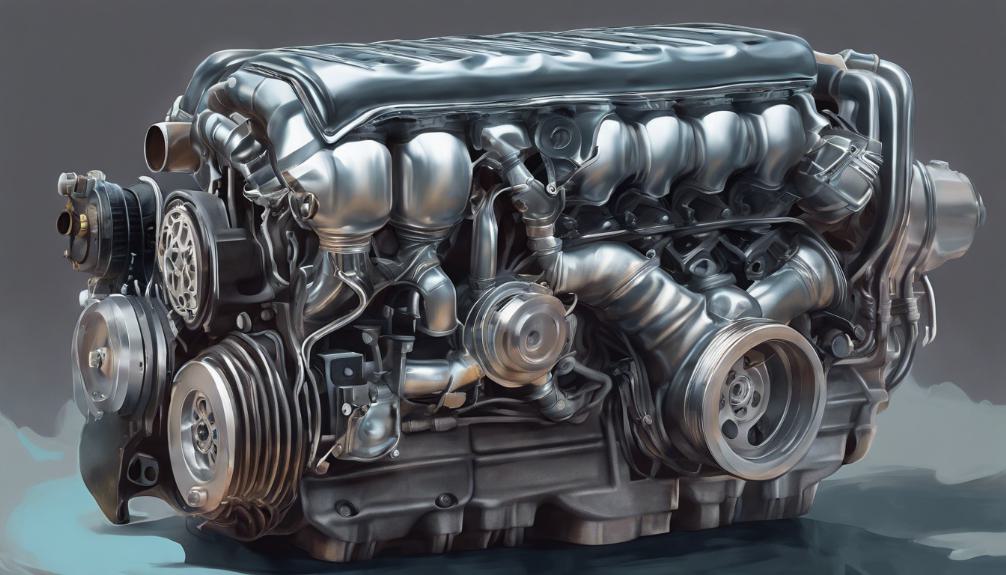When dealing with the P00B7 trouble code for low engine coolant flow, focus on diagnosing coolant circulation and thermostat issues promptly.
Your Chevy’s engine temperature relies on proper coolant flow. A malfunctioning thermostat disrupts this flow. Look out for symptoms like the check engine light and abnormal gauge readings.
Common causes may include low coolant or a faulty thermostat. Check the radiator and sensors for problems. Swift action and OEM parts for replacements are key.
Early intervention can prevent costly engine damage. Further information awaits on resolving coolant flow issues effectively.
Key Points
- Low coolant levels and faulty thermostat are common causes of P00B7 code.
- Regular maintenance like flushing the coolant system is crucial for optimal performance.
- Promptly address the code to prevent potential engine damage.
- Opt for OEM parts when replacing components to ensure reliability.
- Timely intervention and proper maintenance safeguard the engine from overheating risks.
Understanding the P00B7 Trouble Code

If you’re a Chevy owner dealing with the P00B7 trouble code, understanding its implications is essential for addressing the issue effectively.
This trouble code specifically points to problems with coolant circulation and thermostat functionality in your vehicle.
Coolant circulation is vital for maintaining ideal engine temperature, and issues in this area can lead to overheating risks.
The thermostat plays a key role in regulating the engine temperature by controlling the flow of coolant.
A malfunctioning thermostat can disrupt this process, resulting in inadequate coolant flow and triggering the P00B7 trouble code.
It’s important to recognize that Chevy vehicles have low tolerance for engine overheating problems, making timely diagnosis and repair essential.
By focusing on diagnosing and rectifying issues related to coolant circulation and thermostat functionality, you can effectively address the underlying causes of the P00B7 trouble code in your Chevy car.
Symptoms of Low Engine Coolant Flow
Keep an eye out for the check engine light as it’s a common indicator of low engine coolant flow issues. When you notice this light, it could signal problems with coolant circulation in your engine.
Another symptom to watch for is abnormal temperature gauge readings, which may point to issues related to engine overheating due to insufficient coolant flow.
If you observe your radiator fans running at high speeds frequently, it could be a sign of poor coolant flow performance. Then, an increased rich exhaust smell might indicate problems with the engine coolant flow.
Poor mileage and drivability issues are also potential consequences of low engine coolant flow.
By recognizing these symptoms early on, you can address any underlying coolant circulation issues promptly to prevent further complications like engine overheating.
Common Causes of P00B7 Code

When diagnosing the P00B7 code, common causes often include low coolant levels, a faulty thermostat, or water pump issues triggering the alert.
Maintaining your coolant system is crucial to prevent the P00B7 code from appearing.
Regularly check coolant levels and make sure there are no leaks in the system. Troubleshooting tips suggest inspecting the thermostat for proper functioning; a malfunction here can disrupt coolant flow, triggering the P00B7 code.
Also, a faulty water pump can hinder coolant circulation, leading to performance issues.
If you encounter the P00B7 code, it’s essential to address it promptly to avoid engine damage. Ignoring this warning may result in overheating, which can cause significant harm to your vehicle.
Diagnosing Engine Coolant Flow Issues
To address engine coolant flow issues, start by checking the radiator and engine coolant temperature sensor for any potential malfunctions.
Coolant flow diagnostics involve inspecting the radiator for clogs, leaks, or damage that could impede proper circulation.
Troubleshooting the engine coolant temperature sensor includes verifying its readings against the manufacturer’s specifications to guarantee accurate monitoring of the coolant temperature.
Proper engine temperature regulation is vital for maintaining peak performance and preventing overheating.
Regular maintenance, such as flushing the coolant system, replacing worn-out components, and fixing leaks promptly, can help prevent issues with coolant flow.
How Can Low Engine Coolant Flow Performance Affect Turbocharger/ Supercharger Underboost?
Low engine coolant flow can lead to diagnosing turbocharger underboost. Inadequate coolant flow can result in poor turbocharger/supercharger performance, leading to underboost conditions. It is crucial to address any issues with coolant flow to ensure optimal turbocharger/supercharger functionality and prevent underboost.
Addressing P00B7 Code Promptly

Address the P00B7 code promptly to prevent further engine damage and potential overheating risks. To help you tackle this issue effectively, consider the following maintenance tips:
- Early Detection: Act swiftly upon noticing the P00B7 code to avoid exacerbating the problem.
- OEM Parts: Opt for Original Equipment Manufacturer parts when replacing the thermostat and temperature sensors for best performance.
- Test Drive: After replacing the sensors, take the vehicle for a 5-10 minute test drive to assess whether the problem has been resolved.
Preventing Engine Damage With P00B7
To prevent costly engine damage associated with the P00B7 code, taking immediate action is essential. Ignoring the warning signs can lead to serious consequences for your vehicle’s engine performance.
One vital step in preventing engine damage with the P00B7 code is to prioritize cooling system maintenance.
Regular checks and servicing of components like the thermostat and engine coolant temperature sensor can help guarantee proper coolant flow and prevent overheating issues.
By addressing these maintenance tasks promptly, you can safeguard your engine from potential damage and maintain peak performance.
An overheating engine due to low coolant flow can have detrimental effects on various engine functions. Symptoms such as abnormal temperature gauge readings and decreased mileage can indicate underlying issues that need attention.
Driving with a P00B7 code poses risks to your engine’s health, underscoring the importance of timely intervention.
By staying proactive with cooling system maintenance and addressing the P00B7 code promptly, you can protect your engine from damage and preserve its efficiency.
As an Amazon Associate we earn from qualifying purchases.










